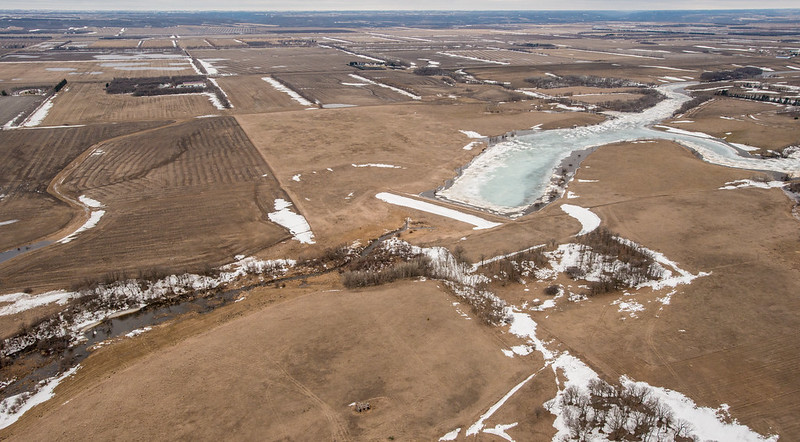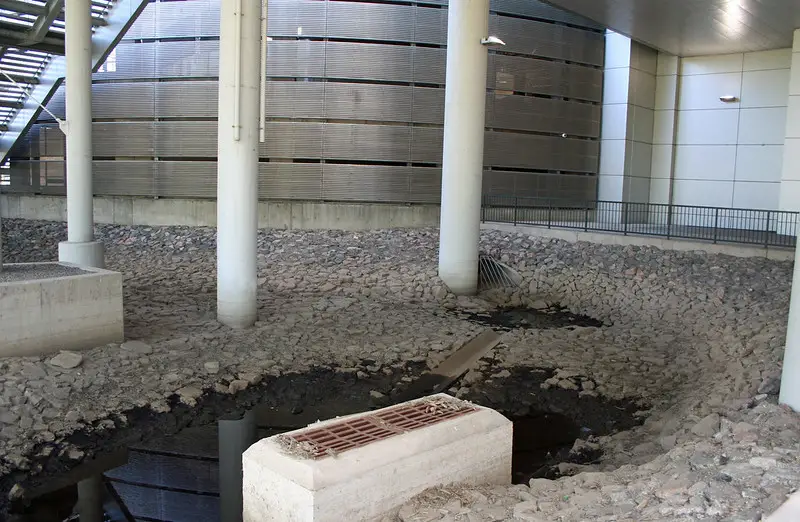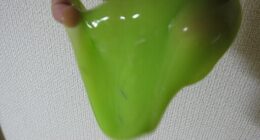Detention and retention basins are two types of structures that serve similar purposes, but they have distinct differences. Detention basins are typically used to reduce flooding by temporarily storing stormwater runoff while it is released at a slower rate downstream. Retention basins, on the other hand, can be used for both short-term and long-term water storage with more permanent systems. Both detention and retention basins can provide effective stormwater management solutions when designed correctly for the specific site conditions.
Detention Basin
(Photo By U.S. Department of Agriculture on Flickr )

A detention basin is a stormwater management facility designed to detain or hold, water for a specific period of time. The water is then released at a controlled rate, typically into a downstream waterway such as a river or stream. Detention basins are typically used to manage stormwater runoff from urban areas and can be either man-made or natural features.
Retention Basin
(Photo By Jeffrey Beall on Flickr)

A retention basin, also known as a wet pond, is similar to a detention basin in that it is designed to hold water for a specific period of time; however, the key difference is that retention basins do not have an outlet for releasing the stored water. As such, retention basins are typically used in rural areas where there are no downstream waterways to receive the stored water.
Detention and Retention Basin – The differences
Detention basins are designed to temporarily hold water from rainfall and runoff events and then slowly release the water back into the environment. Retention basins, on the other hand, are designed to store water permanently. While detention basins can be used for both stormwater management and flood control, retention basins are primarily used for flood control.
Detention basins are typically used to manage stormwater runoff from a developed area like a parking lot or city street. They are designed to temporarily detain water and release it at a controlled rate, preventing flooding and erosion. These basins are typically smaller than retention basins and only hold water for a short period of time, typically less than 24 hours.
Retention basins, also known as storage basins or ponds, are larger than detention basins and are designed to store water for extended periods of time – usually several days to weeks. These basins are often used in agricultural settings to store irrigation water or rainwater for later use. Retention basins can also be used to manage stormwater runoff, but because they hold water for longer periods of time they require more careful design to avoid problems with stagnant water or breeding mosquitos.

When to use each type
Detention basins are most effective when installed in areas with a high potential for flooding. They are also used in areas where the natural drainage is insufficient or has been altered by development. Retention basins are designed to store water for extended periods of time and are used in areas where peak runoff rates exceed the capacity of the natural or modified drainage system.
How to build each type
Detention basins are designed to detain water for a specific duration of time, typically between 24 and 48 hours, before releasing it downstream at a controlled rate. Retention basins, on the other hand, are designed to store water indefinitely until it is absorbed by the surrounding soil or evaporates.
There are several key factors to consider when designing and constructing a detention or retention basin, including:
- The size of the basin: This will be determined by the amount of rainfall anticipated and the desired duration of storage.
- The location of the basin: The basin should be located upstream of any potential flooding areas to provide maximum protection. It is also important to consider access for maintenance and emergency purposes.
- The type of bottom material: This will be determined by the soil conditions in the area and will impact both the cost and longevity of the basin. Common materials used include Clay, sand, and gravel.
- The type of walls: The walls can be constructed with a variety of materials, including concrete, wood, or gabion baskets (wire cages filled with rocks). Again, the choice of material will impact both cost and durability.
Why do I need a detention tank?
A detention basin is designed to detain or hold water for a specific time period, usually between 24 and 48 hours, before it is released downstream at a controlled rate. A retention basin, on the other hand, is designed to keep water on-site permanently.
There are several reasons why you might need a detention tank. If your property is located in an area with a high water table, a detention tank can help reduce the amount of groundwater that enters your basement or crawl space. Additionally, if your property is located in an area that is prone to flooding, a detention tank can help to reduce the severity of flooding by temporarily storing water during a heavy rain event.
Why do buildings need retention ponds?
Stormwater retention ponds are man-made basins designed to detain water from rainstorms and release it at a controlled rate. These ponds are an important tool in stormwater management because they help to reduce flooding and the erosion of property.
One common type of retention pond is the wet pond, which is designed to store water on site until it can be slowly released into the environment. Wet retention ponds are typically lined with vegetation, which helps to filter out pollutants and improve water quality. Another type of retention pond is the dry pond, which is designed to quickly drain after a storm. Dry ponds are often used in areas where space is limited, such as urban areas.
Retention ponds are an important part of the stormwater management system because they help to control the release of stormwater runoff. By managing the release of stormwater, retention ponds help to reduce flooding and protect property from erosion.
How can retention ponds prevent erosion?
Erosion is the process of water and wind wearing away at rocks, soil, and other surfaces. Over time, this can lead to serious problems like sinkholes and landslides. Retention ponds are a type of basin that is used to prevent erosion by holding water back and allowing it to seep into the ground slowly. This helps to keep the ground from being washed away and also prevents pollutants from running off into waterways.
What are the three methods of flood control?
There are three primary methods of flood control: Detention, Retention, and Diversion.
Detention basins are designed to temporarily hold water during a storm event and then release it slowly back into the environment afterwards. These types of basins are often found in urban areas where space is limited.
Retention basins are similar to detention basins, but they are larger in size and designed to hold water for a longer period of time. This is done by release the water back into the environment at a slower rate.
Diversion channels are typically used in rural areas and work by redirecting excess water around populated areas to prevent flooding.
How do detention basins prevent floods?
Detention basins are designed to detain water for a specific period of time, typically the duration of a storm event. The detention basin acts as a temporary storage facility for runoff from precipitation events and typically has a permanent pool of water at its base. The detention basin outlet structure controls the release of stored water back into the natural drainage system.
Retention basins are also designed to temporarily store water, but they differ from detention basins in that they do not have a permanent pool of water at their base. Retention basins are used to manage stormwater runoff by releasing it at a controlled rate back into the natural drainage system.
Frequently asked questions about detention and retention basins
How do you measure a retention basin?
The size of the retention basin will be based on the amount of runoff from the site, the frequency of storms, and the soil infiltration rate.
What is drainage and retention?
Drainage is the process of removing water from an area. This can be done through natural means, such as evaporation and transpiration, or through man-made means, such as pumps and drainage systems. Retention is the process of holding water in an area. This can be done through natural means, such as infiltration and percolation, or through man-made means, such as dams and reservoirs.
Can you swim in a retention pond?
Yes, you can swim in a retention pond, but there are some risks involved. The water in retention ponds is typically stagnant and can contain harmful bacteria. Additionally, the sides of the pond may be steep and slippery, making it difficult to get in and out.
How deep is a detention basin?
A detention basin is a water-holding structure designed to detain or hold water for a short period of time. The depth of the basin is typically shallower than a retention basin.
Do retention ponds attract mosquitoes?
Retention ponds are often used as a method of mosquito control, as they can help to reduce the breeding population of mosquitoes. However, it is important to remember that retention ponds will not completely eliminate the mosquito problem in an area. They can, however, help to reduce the number of mosquitoes by providing a place for them to breed and live.
Do retention ponds dry up?
It is common for detention and retention ponds to dry up during the summer months when evaporation rates are highest. However, retention ponds are designed to retain water permanently, while detention ponds are designed to detain water for a specific period of time before releasing it. As a result, retention ponds typically have a much higher capacity than detention ponds and are not as likely to dry up.
Featured Image By – Jeffrey Beall on Flickr








